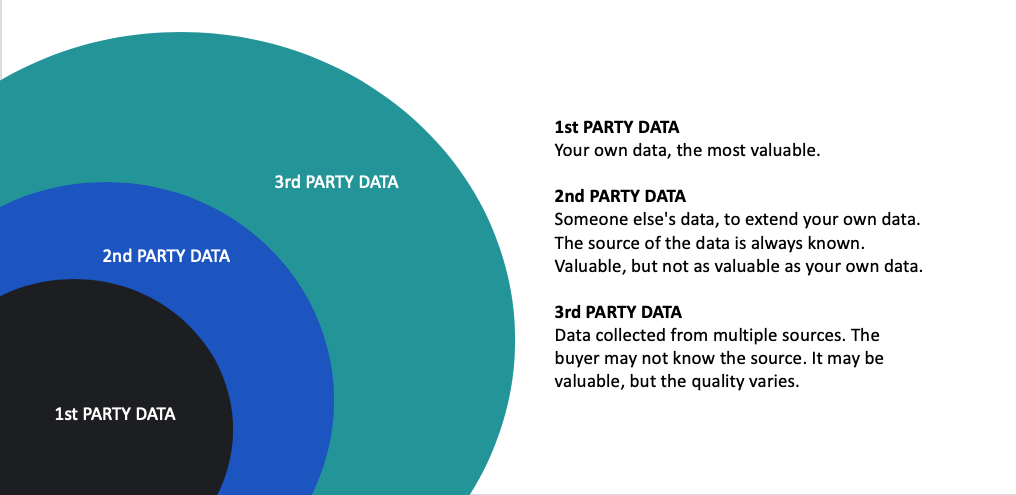The era of one-to-many engagement is over. Your customers need each experience to be relevant – something as simple as knowing what pages a customer has looked at on your site before they call the help centre can go a long way. Without personalised, relevant experiences, consumers will choose to go elsewhere, whether you’re a B2C or a B2B company.
Customer data is what fuels the teams and technologies responsible for your customer experience, but for years there was little incentive for companies to prioritise customer data as an asset itself to be taken care of and safeguarded. Now, consumers and regulators alike are pushing for new data privacy rights. These rights, like the ability to know what data companies collect, to delete that data, and to compel legal action when it’s misused, are now compelling every company to pay attention to the data.
Companies like Apple and Google are using privacy as a marketing tool. Browsers are competing for users based on how safe their products are. As a result, many third-party data sources have been drying up. Marketers are losing access to data that once fueled their ad campaigns due to changing attitudes and laws around privacy.
To take on personalisation and privacy, you need a unified view of customer data at an individual level to deliver relevant experiences with consent. It’s a stark change from the past when siloed teams worked in siloed tools to deliver scattershot campaigns. Not only is this a bad experience, it opens you up to risk.
The demise of third-party data won’t mean the end of marketing or cross-departmental CX. What it does mean: to scale engagement across all of your tools and all of your channels— accurately and with consent— you need to rethink the kind of data you’re using, how you’re collecting it, how it’s distributed, and how you keep it secured.
So how do organisations address this challenge today? What data should you collect, how can you protect it, and— most importantly— how can you ensure you’re delivering experiences that matter to your customers?
Know what data types are relevant to personal experience
Now, more than ever, where you get your data matters. That’s why understanding the difference between the different types of data— first-party, second, and third— is critical to plotting out the right strategy to keep your data secure and your customers happy. While first and third-party data are the most commonly discussed, it’s also important to understand zero and second-party data.
While third-party data has comprised the majority of the data that marketers and analysts work with (because it was easy and readily available), the evolution of data privacy regulations and the rigours of crafting personalised customer experiences are elevating first-party data.

Third-party data is less than ideal to meet those two demands. It can be risky and error-prone, and for companies that rely on it, that data will be harder to come by and work with in the future. The CCPA specifically defines the structure and handling of third-party data to ensure that it is indeed anonymous and never “de-aggregated,” making it more arduous to manage an increasing effort of doing so beyond the scale of ROI. And if your company is selling third-party data (advertisers, for example), the challenges increase even more.
First-party data, on the other hand— along with zero-party data— are collected and controlled
by you. Thus, it allows you to establish efficient automation aligned with privacy requirements and marketing needs because you have to earn consumers’ trust first.
Since this data is collected on your web properties, apps, or independent systems and sources of
data, the information can flow in real-time from the moment it is produced. That is, of course, assuming you have set up a customer data supply chain connecting customer data to the systems that deliver the customer experience.
Switch to a first-party data strategy now
The days of delivering marketing outcomes and CX strategies based on third-party data
are coming to an end. However, the degradation of third-party data’s value doesn’t mean personalisation or marketing is over. Even in the world of display advertising.
When SPRING, a company within Axel Springer, Europe’s largest publisher, was faced with continuing their web advertising in a post-GDPR world, they needed a way to personalise their ads while remaining compliant with regulations. Faced with ad-blocking rates as high as 30 per cent within European countries in the EU, SPRING Axel Springer adopted a first-party data approach to their ads by employing a combination of enterprise tag management and a Customer Data Platform.
Even though they historically operated with third-party data, they were able to transform their digital strategy by using first-party visitor data to enrich their desired DSP segments and create personalised, dynamic advertising campaigns. This not only improved conversions but switching to a first-party data strategy helped align teams across the organisation who were now relying on a unified set of customer data. (Regular readers of this blog will appreciate the distinction between personalisation and segmentation and the power the former has over the latter).
Third-party data can be very helpful as a complement to your first-party data. But it shouldn’t be relied on for long-term strategies. The temptation of third-party data is that seems like a simple way to ramp up your sales funnel, but the cost and the outcomes leave little margins in most cases. The value of first-party data is realised when you have a strategy in place to turn it into actionable insights that continue to get better— not worse, like third-party data— over time. The introduction of AI technology to do this for you has been the greatest leap into the future.
The Benefits of a First-Party Data Strategy
Switching your marketing and CX strategy to a first-party data strategy isn’t swapping out one set of data for another. It’s complementing this existing approach with richer and more strategically aligned data that maps to your organisation’s revenue goals. Building a first-party data strategy (which we’ll cover next) requires a robust yet adaptable customer data supply chain to move from collection to unification to activation. The myriad of activities of a busy ecommerce site is a luxurious reservoir of all the data potential you could ever want as every individual consumer tells you, by their actions, exactly what they want and when.
Turning to a first-party data strategy unlocks a host of use cases that can help you unlock long-promised business goals like digital transformation. Let’s take a look at what first-party data can enable your company to do when you pair the right technology with the right people and strategy. We’ll only cover a few new capabilities, including scalable customer acquisition, a single view of the customer, improving time to insight, and governing data according to customer consent. Depending on your industry and CX/Marketing needs, your first-party data strategy may focus on other goals.
Scalable Customer Acquisition
Collecting first-party data is the first step— an email, a social media handle— but getting them to become customers is another hurdle. As consumers bounce between touchpoints, companies need to be able to react across channels in real-time. By integrating all of your data sources into a vendor-neutral customer data supply chain, you’re better able to analyse and engage individual users’ actions. Down the line, this provides an opportunity for personalised marketing that turns consumers into customers.
One of the ways you can do this is through lookalike marketing. You know what your high-value customers look like and how they act. Turning that first-party data (purchase and behaviour data) into targeted campaigns to convert other like-individuals into high-value customers (whether that data comes from a first or third party) is now possible. By using first-party data to craft highly targeted ads to directly target consumers who are displaying intent and affinity to become high-value customers, you not only generate higher lifetime values but save money by reducing unnecessary ad spend.
Improve Time to Insight
First-party data is great, but there is so much data in so many places that generating high-quality insights can be slow and laborious without the right strategy in place. With a vendor-neutral customer data supply chain, you can reduce the time-to-insights needed to generate revenue. If you can identify and engage consumers from the first moment instead of seven days later, then you’ve got a much better shot at striking while the iron is hot.
Time to insight depends on your ability to capture high-quality data and correlate it to individual profiles in real-time— also known as identity resolution. With a Customer Data Platform, you can use any one of multiple identifying data points for visitors as the north star through which to stitch all of that valuable first-party data together. From there, data can be analysed at the individual level and put to work in various channels to provide better experiences or deliver hyper-personalised messaging.
Govern Data Use According to Customer Consent
One of the inherent challenges of third-party data is managing the complexity of consent and various overlapping regulations. The same goes for first-party data, though you’ve cut out the middleman (which is very helpful). When consent is captured on your website (via those ever-present banners), the opt-ins and opt-outs must be tied to a profile and acted upon. Because there are a variety of things to opt in or opt out of, managing what data needs to be shut down and what data can continue to be collected gets tricky.
With a Customer Data Platform linking consent data to the customer profile (which is tied to all of your data sources), the labour involved with complying with regulatory privacy legislation is drastically reduced, making data auditing and traceability scalable. Let’s say that this customer has said that they only want to opt-out of your personalisation cookies and data collection, then the customer’s data will not be added to on-site (personalisation/display), yet could still be added to social/email. Without a single point of data control through the CDP, companies run the risk of acting against the customer’s wishes because the preferences have yet to be disseminated.
Putting It All Together
The evolution of how companies collect and use data in this era of consumer privacy has the interesting effect of levelling the playing field for once-disparate industries. Highly regulated industries like financial institutions and healthcare are developing customer-centric policies and experiences that have been a hallmark of high-growth retail companies for the last 15 years. On the other hand, those high-growth retail and travel companies are facing stiffer regulations on the way they use data— not yet at the level of HIPAA, but heading there.
The companies that are taking their first-party data strategy seriously by investing in Customer Data Platforms, robust server-side and client-side data management, and machine learning capabilities are the ones leading their industries into this new era of privacy and personalisation.
Leading healthcare companies we work with like Providence St. Joseph Health are turning their attention to more personalised experiences. PSJH, for example, is tying together offline and online data sources to personalise their patient call centres. With Tealium AudienceStream CDP delivering first-party data to enrich data from the CRM, PSJH call agents have detailed, real-time information to understand who is calling and where they came from— providing faster, better experiences in an industry where time is of the essence. Doing this while maintaining the security of data that is expected of a healthcare provider requires a rock-solid customer data supply chain.
When GDPR arrived in the EU, leading European hotelier Barcelo Hotel Group sought to create a governable data supply chain as the backbone of their customer-centric vision for the company. When they relied on marketing agencies and third-party data, they didn’t have access to all of their data, making it difficult to keep up with their own business needs and the needs of their customers. By pairing Tealium’s Tag Management System and Customer Data Platform with Barcelo’s Best-of-Breed Marketing Cloud and Data Management Platform, Barcelo significantly improved its advertising success, even in Europe’s increasingly regulated environment. In two years, Barcelo increased revenue by 37% and decreased marketing costs by almost 6%.
At the end of the day, whether you’re in healthcare, retail, travel, restaurants, technology, or even government, consumers expect the same thing: seamless customer experiences personalised to their tastes, multiple channels through which to engage, and the ability to trust that their data is in good hands.
With the right customer data technology at the heart of your first-party data strategy, you’ll have the ability to adapt to new data sources, feed that data into advanced technology like machine learning, and scale for future growth.
That technology, if you haven’t guessed it already, is the Customer Data Platform. While
it does not stand alone, it is the cornerstone of a customer-centric approach to first-party data collection and use. It enables your personalisation efforts while helping you meet the demands of privacy regulations.
Switching to a first-party data strategy won’t happen overnight, but you can unlock the pathway by investing in a data-first Customer Data Platform.





